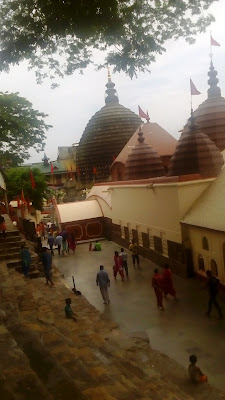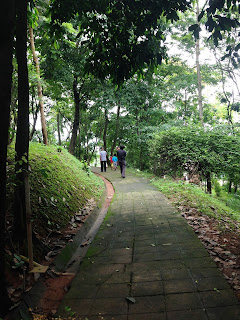This June, my husband was visiting Guwahati after two years. And he was clear that he would like to see more of the city than my relatives, unlike his earlier two visits when Guwahati just meant my relatives' houses. So I did the smart thing. I went home in May, escaping the Delhi heat and immersing myself in the rains and the sweet smell of the rain touched earth. I spent as much time as possible with my lovely parents, lounging in the verandah with a book in my hands and gloriously staring away at the rains. Oh the rains! After all that Delhi heat! I ate veggies from my dad's garden to my heart's delight and felt as fresh as I could with all that organic food and the rains. There were friends to catch up with, good old friends with whom I had a great time. Then came my husband in June, delighted to see all that rain. He came for just seven days - nothing if one wants to travel around these parts of the country. So it meant no trips to upper Assam or Shillong or Cherapunjee for us. He decided to be the perfect tourist in Guwahati. And I, happy to let my mom take care of my daughter, accompanied this tourist. Here are a few pictures from those days of 'touristing'!
Note: This piece has been reprinted by The Thumbprint in June 2015 (http://www.thethumbprintmag.com/touristy-husband-in-guwahati-brahmaputra-kamakhya/)
The most compelling prayer, kneeling down to nature. This is at North Guwahati, on the other bank of the Brahmaputra. This part of Guwahati is still untouched by the 'development' madness that has come to afflict Guwahati city (which is technically South Guwahati, on the other side of the river).
Till the Xaraighat bridge was constructed over the Brahmaputra, people took ferries to travel between north and south Guwahati. This spot is right outside my father's maternal grandparents' house.
Photo: Nadeem
I told my husband and daughter how my father stayed with his maternal uncles here in North Guwahati while doing his higher secondary (then called intermediate) from Cotton College. He would take the ferry everyday from these shores to the other bank, and then walk up to the college. Just in case you are thinking, it does not make a very long walk :)
I remember my grandmother telling me how, when she was a little child, the whole family had rushed to the banks of the Brahmaputra to welcome one of the brightest stars of this Mazindar Baruah family - Ananda Ram Baruah, the first person from Assam to go to England for studies. He matriculated at the age of fourteen, was the first Assamese to study law in England and was the first Assamese civil servant (India was under the British then).
I pose with my daughter and a favourite cousin, Kasturi who also happens to be my dad's favourite cosuin's (Bap Khura) daughter. Photo: Nadeem
This is the entrance to the Auniati Xatra at North Guwahati. It is a branch of the main Xatra in Majuli. Photo: Nadeem
Entering the Auniati Xatra.
Within the compound of the Xatra. Once many years ago, I had met the century old caretaker of this Xatra who was sitting here right at this spot, reading a newspaper without any glasses. He is no more but everybody in North Guwahati remembers him and his warm presence in this Xatra.
The Kamakhya temple at the Neelachal Hills, Guwahati. I don't visit places of religious worship unless it holds some cultural or historical attraction. But even then, if someone were to ask me where, I would say Nizamuddin Dargah in Delhi and Ma Kamakhya in Guwahati. I don't go to these two places looking for anything but those moments of peace I find within their premises even in the midst of frenzied behaviour by devotees.
Devotees from all over India at Kamakhya temple. Photo: Nadeem
By a stroke of luck, we happened to visit Kamakhya just as it was gearing up for the Ambubachi mela - the festival that celebrates the menstruation period of Goddess Kamakhya. The 'yoni' of the Goddess is supposed to be located here. Hence, for these seven days in June though the temple stays closed, yet devotees from all over the world come here to receive energy. As my aunt Emi Pehi mentioned the other day, the little pond in the temple premises turn blood red during this time and devotees dip themselves there to take in the energy.
Photo: Nadeem
A devotee who has arrived for Ambubachi mela well in advance.
Photo: Nadeem
Devotees who have turned up for the Ambubachi mela. Photo: Nadeem
Devotees at Kamakhya who have come for Ambubachi mela. Photo: Nadeem
The sacrificial goats and pigeons at Kamakhya. Photo: Nadeem
Now this is at Kalakhetra, the wonderful institution that represents the diverse cultural and historical entities of Assam. One can see here in the background the replica of the Rang Ghar in Sibsagar. The Ahom kings, in the medieval times, used to be seated at the first storey of the Rang Ghar during festivals and watch buffalo fights on the ground below.
A walk through the trees. I remember visiting this place while in school with my dear friend Tahin, whose father Ratna Ojah was the director of Kalakhetra at that time and it was he who shaped up this wonderful project. Uncle had given us (Tahin's friends) a tour of Kalakhetra even before it was opened to public. How privileged we felt!
Kalakhetra. It has beautiful murals and sculptures depicting Assamese life from yonder years. It also houses a great museum and a craft training centre.
Looking outside from a tea stall at Kalakhetra.
This is at Panikheti. My cousin Phu and her husband Chintu took us there, to this lovely resort Eastern Retreat which has this view. The resort is right where the water ends.
Panikehti. Beautiful Panikheti.
I also took the husband to the Guwahati Zoo. When we were young, we were told that sanctuaries are natural and zoos are often man made. This Guwahati Zoo is the only natural zoo in India, we were told while in school. Now I don't know how true that is, but the zoo is indeed lovely, and I have always loved it, with its huge trees and plants besides of course the animals.
The hubby caught a friendly Hippopotamus!
I captured a few pelicans right at the mouth of the zoo. Thereafter, I was too caught up with the sights of nature and the animals to click any more pictures. We saw a few white tigers, and two royal Bengal tigers. We also saw how meat come for them in buckets; the caretaker throws them into the cages and releases the doors for tigers to come in for the food. I was struck by how one tiger came at a time, picked up one piece of meat and left for the next tiger to come and pick its share. They were disciplined and not fighting for food!
This I had to put up. The husband took this picture from the train as it entered Assam. The landscape just changed, he said, to such lush green that he stood by the door of the coach, taking in the beauty for as many hours as he could.
Here's another picture from the train by the hubby. You can see how the hills become the clouds and the clouds become the hills in the distance.
Note: This piece has been reprinted by The Thumbprint in June 2015 (http://www.thethumbprintmag.com/touristy-husband-in-guwahati-brahmaputra-kamakhya/)


























